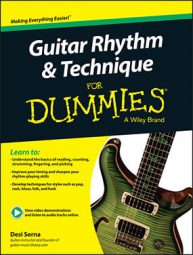In most performance situations, guitarists aren’t given a score that includes all their parts note-for-note. Instead, they receive a lead sheet or chord chart, which is a condensed version of the music with all the basic information necessary for a band to play the song together. As you work with a lead sheet, pay attention to its most important details:
The key: If you understand how to read key signatures, you can determine the key that way. Many guitarists simply glance at the chords and get an idea of the key.
For example, if you see a chord progression like G–D–Em–C, you should immediately recognize it as I–V–vi–IV in the key of G. When oriented in the proper key, you comp with corresponding chords and scales. Be sure to work out a few scale patterns to use before starting the song.
The chord progression: Most songs have sections that follow a repeated grouping of chords called a progression. Identify the song’s intro, verse, chorus, and bridge chord changes and rehearse them prior to the beginning so that each section is familiar to you when it comes up.
The riff or melody: This is often where some basic sight-reading is useful. Some lead sheets notate important parts that should be played as written. If there is a particular hook that needs to be played on guitar, work it out ahead of time. When push comes to shove, take a brief moment during rehearsal to ask another instrumentalist, like a pianist, to read and play the part for you so that you can copy it by ear, if that’s how you learn best.
The form: The form of a song is the order of its individual parts. The band needs to transition section to section perfectly in sync. There’s no time to look around and try to figure out where you’re at!
This is the primary purpose of a lead sheet, to keep all band members on track as they progress through a song. Of utmost importance is following endings, repeats, and cues to skip to other sections, like codas. You should know where you are and where you’re going next at all times. Tap your foot, count through each measure, pay attention to the chord changes, and follow the form. If your chart also includes lyrics, use the words to stay on track.
Rhythms: When it comes to rhythm, you want to identify on which beats the chords change. You may have the progression memorized, but if you didn’t bother to notice how long to play each chord, or at what point during a measure to change chords, you’re going to derail.
Occasionally, there are moments when it’s critical to play a very specific rhythm, perhaps a point when the whole band rests or accents together. Sometimes the chord changes are accompanied with a sample rhythm that merely serves as a suggested example on how you should comp the chords, and other times it’s critical to play a rhythm exactly as notated. Know the difference!
Dynamics and performance notes: Pay attention to any added information written in the lead sheet that indicates how and when you should play. For example, piano means soft and forte means loud. Guitar out is a good indication that you shouldn’t be playing! Crescendo (<) and diminuendo (>) symbols signify to get louder and softer. The words guitar solo signify to let ‘er rip! Some lead sheets even tell you whether a guitar part should feature distortion or a particular effect.
Listening to the recording: Just because you’re handed a lead sheet doesn’t mean that you must rely solely on it. You may pick up on a song’s groove, parts, and form better by listening to it first.
Recordings are also helpful for double-checking the lead sheet for errors and discovering any aspects of the performance not notated. When you notice differences, write them down on your lead sheet and discuss them with the band.

